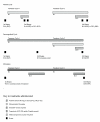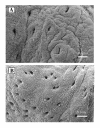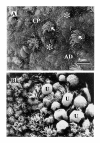Endometrial response to IVF hormonal manipulation: comparative analysis of menopausal, down regulated and natural cycles
- PMID: 15117407
- PMCID: PMC420259
- DOI: 10.1186/1477-7827-2-21
Endometrial response to IVF hormonal manipulation: comparative analysis of menopausal, down regulated and natural cycles
Abstract
Background: Uterine luminal epithelial cell response to different hormonal strategies was examined to determine commonality when an endometrium attains a receptive, stimulated, morphological profile that may lead to successful implantation.
Methods: Endometrial biopsies from 3 cohorts of patients were compared. The tissue samples taken from these patients were categorized into 8 different groups according to their baseline and the hormone regime used.
Results: Pre-treatment natural cycle tissue was variable in appearance. Downregulation with a GnRH analogue tissue appeared menopausal in character. HRT after downregulation resulted in tissue uniformity. HRT in menopause resulted in a 'lush' epithelial surface. HST in the natural cycle improved the morphology with significant difference in secretion between the two regimes examined.
Conclusions: Down regulation plus HRT standardized surface appearance but tissue response is significantly different from the natural cycle, natural cycle plus HRT or menopause plus HRT. HRT in menopause reinstates tissue to a state similar to a natural cycle but significantly different from a natural cycle plus HST. HST with a natural cycle is similar to tissue from the natural cycle but significant differences reflect the influence of the particular hormones present (at any point) within the cycle.
Figures






References
-
- Ljungkvist I. Attachment reaction of rat uterine luminal epithelium. I. Gross and fine structure of the endometrium or the spayed, virgin rat. Acta Soc Med Upsal. 1971;76:91–109. - PubMed
-
- Ljungkvist I, Nilsson O. Blastocyst-endometrial contact and pontamine blue reaction during normal implantation in the rat. J Endocrinol. 1974;60:149–154. - PubMed
-
- Murphy CR. The plasma membrane of uterine epithelial cells: structure and histochemistry. Prog Histochem Cytochem. 1993;27:1–66. - PubMed
-
- Murphy CR, Rogers PA, Leeton J, Hosie M, Beaton L, Macpherson A. Surface ultrastructure of uterine epithelial cells in women with premature ovarian failure following steroid hormone replacement. Acta Anat (Basel) 1987;130:348–350. - PubMed
-
- Rogers P, Murphy C, Cameron I, Leeton J, Hosie M, Beaton L, Macpherson A. Uterine receptivity in women receiving steroid replacement therapy for premature ovarian failure: ultrastructural and endocrinological parameters. Hum Reprod. 1989;4:349–354. - PubMed
Publication types
MeSH terms
Substances
LinkOut - more resources
Full Text Sources
Medical

